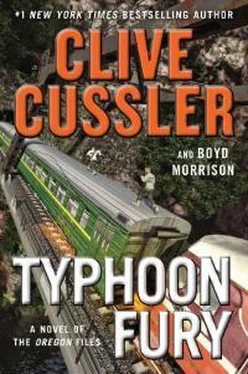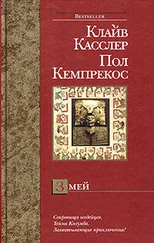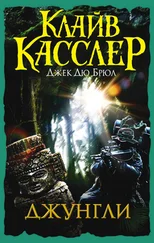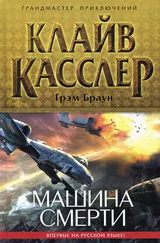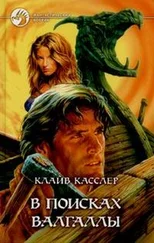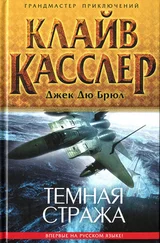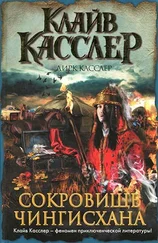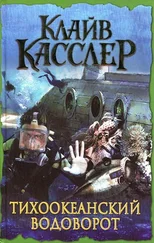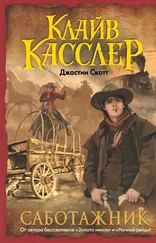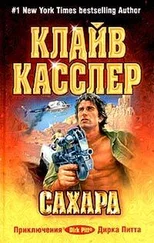Raven had a point. If his gang still had the other Gardner paintings, a report to Interpol might make them too hot to handle. They could all be destroyed to wipe out the evidence.
There was still the microtransmitter Beth had attached to the finial. “Tagaan was holding the bronze eagle when we left. We can track it.”
“If they really have an informant at Interpol, they’ll know as soon as we start following it and deactivate the transmitter.”
“That’s why we’re not going to Interpol,” Beth said.
“Then how are we going to recover the other paintings? We can’t do it on our own.”
“The guy who gave me the transmitter can help us. I consult with him on art that he acquires for his firm. His name is Juan Cabrillo.”
14
THE PHILIPPINES
In his spartan private quarters, Salvador Locsin wolfed down a huge traditional Filipino breakfast as if he were an athlete training for the Olympics. Heaping plates of corned beef, garlic-fried rice, salted milkfish, and chocolate rice pudding took up nearly the entire teak table. In the week since he was shot by his own men escaping from the prison transport, every one of his meals was a feast. It was the fuel his body needed to recover from his bullet wounds, injuries that would normally have confined someone to a hospital for weeks. Not only did Locsin feel better than ever, his scars were barely visible and would be completely gone in a day or two.
Locsin had grown up the son of a local politician and a teacher. As avowed socialists, his parents had been at the forefront of the island’s agitation for better services for the people. Then an attempt by the police to break up a socialist rally went bad.
The police claimed they were there to arrest radical elements of the communist insurgency when someone in the crowd started firing. The police fired back, and Locsin’s parents were supposedly caught in the cross fire and killed. The subsequent investigation concluded that the radicals were at fault, but Locsin knew better. Witnesses told Locsin that his parents were deliberately shot by the police, but the final official report covered it up.
Locsin could see that there’d be no justice for his parents, so he didn’t return to his university. Fighting corruption by working through a rigged system was obviously a useless gesture. Joining the communist insurgency was his best chance to take down a government designed for the benefit of the rich and then rebuild it from scratch.
As he demonstrated his tactical abilities for inflicting maximum damage on government targets, he quickly gained a following in the insurgency. His methods became increasingly brutal because he adhered to Machiavelli’s maxim The ends justify the means . When financial support from the communist governments of China and North Korea wasn’t enough to fund his rebellion, he turned to smuggling drugs. The main consumers of his heroin and methamphetamine products were the rich capitalist countries, and he took satisfaction in knowing that the narcotic epidemic helped weaken those supposedly robust economies.
But, until now, nothing he had accomplished was revolutionary enough to make a real difference. It was another drug that would soon let him transform the world.
As he shoveled another spoonful of pudding into his mouth, Locsin glanced down at the round white pill sitting in a small dish next to his plate. It was etched with the symbol of a swirling cyclone and symbolized the wholesale destruction he was about to unleash.
Nikho Tagaan, a trusted comrade who had been with Locsin since the beginning, opened the door to his quarters and brought in a fresh pot of coffee. He poured mugs for both of them and took a seat on the opposite side of the table.
“Any progress from our laboratory on Luzon?” Locsin said, between bites of pudding.
“Nothing yet. Dr. Ocampo hasn’t been able to isolate the formula and he doesn’t have an estimate for when he will.”
“Does he understand the urgency of the situation?”
“I made that very clear when I was there yesterday. He’s as motivated as we are, but he says that without the original list of the drug’s components, it’s virtually impossible to re-create.”
Locsin picked up the white pill and twirled it between his fingers like a worry bead.
“Why is this so hard to duplicate?”
Tagaan slurped his coffee and shrugged. “I don’t understand the chemistry. Ocampo says he doesn’t know what plant makes up the key ingredient and he can’t produce a replacement for it. It would be like trying to make cocaine without coca leaves or heroin without opium poppies.”
“What about a synthetic substitute?”
“If that was even possible, he said it would take years of research to create.”
Locsin’s uncontrollable rage that emerged on an ever more frequent basis threatened to bubble to the surface, and it took all his will to suppress it.
“We don’t have years,” he growled, popping the tablet in his mouth and washing it down with the coffee. He knew it would take several minutes for the drug to take effect, but a rush of invincibility surged through him. He’d been smart enough to sew an emergency supply of pills into the waistband of his pants, which was why he’d still been able to take his daily dose while in police custody.
When several of his men had been in retreat from police forces through the jungle, they had stumbled upon a cache of twenty thousand pills. The tablets had been stored in a secret underground bunker built by the Japanese in the middle of Negros Island during World War II, but the base must have been abandoned during the American assault. The entire supply of pills had been vacuum-sealed and stored in a steel drum with no papers to explain the contents. A code name was stenciled on the drum: Typhoon .
There were many guesses as to the drug’s purpose. Was it a narcotic? A stimulant? The Japanese were notorious for providing their kamikaze pilots with crystal meth. Or perhaps it was a poison for their soldiers to commit suicide with instead of surrendering. An antidote? An antibiotic? There was no way to tell.
Locsin could have sent the pills for analysis to a scientist sympathetic to their cause, but that would have taken too long. He used a more expedient method: he made one of his government prisoners take the pill.
It didn’t take long to observe the effects on the obese bureaucrat, an Interior Ministry functionary named Stanley Alonzo. Every day, Alonzo’s physical transformation was noticeable. He complained of constant hunger, and each time he was fed, his muscles grew rapidly and he shed fat as if he were exercising ten hours day. Torturing him for information became less fruitful as he fiercely resisted the beatings, seemingly oblivious to the pain being inflicted. Bruises healed in hours instead of days. Then when the drug was withheld, Alonzo’s muscles withered, and torture again became intolerable. His drug doses were restored, and within another week, his metamorphosis was so total and dependent on Typhoon that Locsin thought he could be effectively controlled and become an agent for their side. Alonzo was sent back to his post to spy for the insurgency.
In his research, Locsin discovered that steroids had been developed by the Germans in the lead-up to World War II to treat dysfunctional growth syndromes. The scientists even received the 1939 Nobel Prize for their work. Then, during the war, anabolic steroids were used to help malnourished German soldiers gain muscle mass long before they were distributed to athletes in the Soviet Union and East Germany so they could dominate the Olympics.
But Typhoon did more than improve strength and stamina far beyond anything possible with anabolic steroids. The Japanese had apparently developed a drug that enabled the user to tolerate an inhuman level of pain, rapidly healed wounds normally considered fatal, and allowed users to recover from grievous injuries within days instead of weeks or months. Typhoon was like steroids on steroids. Users weren’t invincible—broken bones and bullet holes didn’t mend themselves in seconds like they did for superheroes in movies—but quick blood clotting and accelerated tissue regeneration meant that almost nothing less than a headshot or a knife to the heart would be lethal. All the user needed was time and food to fuel the repair process.
Читать дальше
